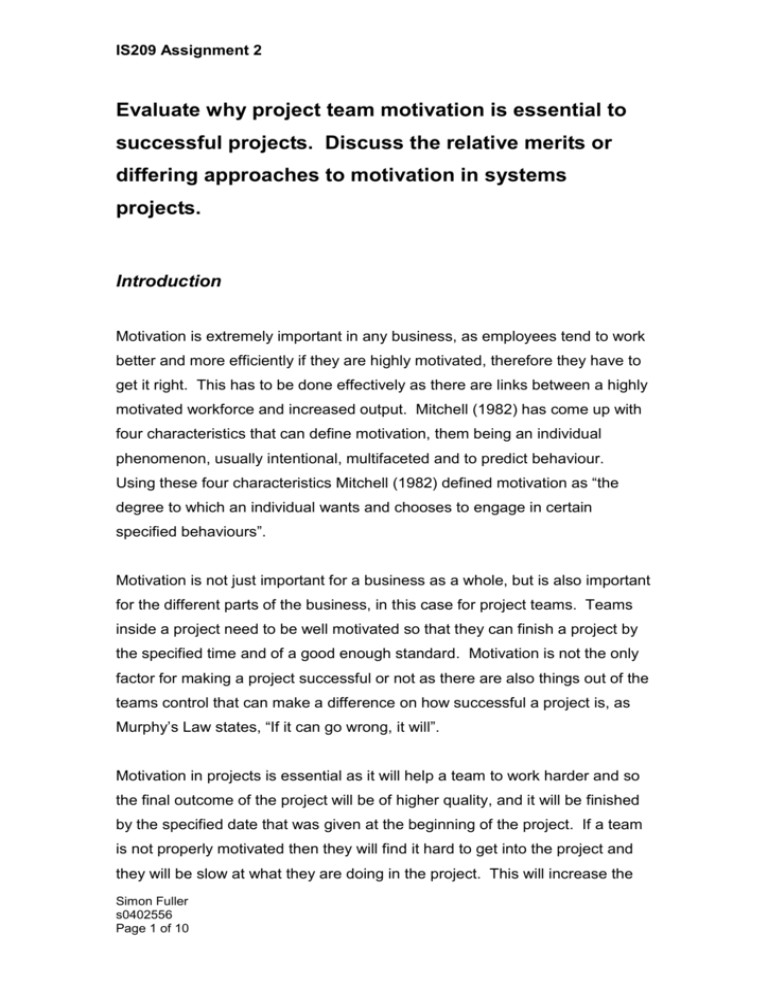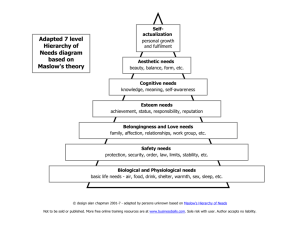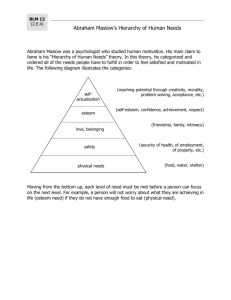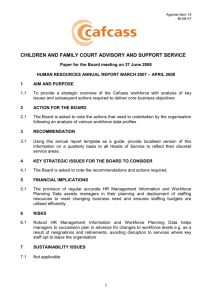Evaluate why project team motivation is essential to successful
advertisement

IS209 Assignment 2 Evaluate why project team motivation is essential to successful projects. Discuss the relative merits or differing approaches to motivation in systems projects. Introduction Motivation is extremely important in any business, as employees tend to work better and more efficiently if they are highly motivated, therefore they have to get it right. This has to be done effectively as there are links between a highly motivated workforce and increased output. Mitchell (1982) has come up with four characteristics that can define motivation, them being an individual phenomenon, usually intentional, multifaceted and to predict behaviour. Using these four characteristics Mitchell (1982) defined motivation as “the degree to which an individual wants and chooses to engage in certain specified behaviours”. Motivation is not just important for a business as a whole, but is also important for the different parts of the business, in this case for project teams. Teams inside a project need to be well motivated so that they can finish a project by the specified time and of a good enough standard. Motivation is not the only factor for making a project successful or not as there are also things out of the teams control that can make a difference on how successful a project is, as Murphy’s Law states, “If it can go wrong, it will”. Motivation in projects is essential as it will help a team to work harder and so the final outcome of the project will be of higher quality, and it will be finished by the specified date that was given at the beginning of the project. If a team is not properly motivated then they will find it hard to get into the project and they will be slow at what they are doing in the project. This will increase the Simon Fuller s0402556 Page 1 of 10 IS209 Assignment 2 amount of time it takes to finish a job, and will not be good for the team as a whole as it will put added pressure onto the rest of the team as they have to finish the project to a high standard and have to finish it by the deadline. Motivation Theories Vroom was the first person to specifically have a theory for motivation at work, known as the Expectancy theory. This expectancy theory is based on that there is a distinct relationship between the level of performance and the expected reward after performing. So in other words a person will only perform well if they know that there is a good chance that they will be rewarded at the end of it. Vroom’s theory is based on three variables, valence, instrumentality and expectancy. Valence is the way people feel about certain outcomes, so in other words it’s how attractive an outcome would be for them and Vroom’s (1982) definition is that valence is the “anticipated satisfaction from an outcome”. There are two levels of instrumentality, first-level and second-level. First-level outcomes are all performance related, so consist of outcomes such as high productivity, whereas the second-level outcomes are all need related, so consist of a good wage and promotion. With expectancy, Mullins (2005) suggested that people “developed a perception of the degree of probability that the choice of a particular action will actually lead to a desired outcome”. Just as with probability for mathematics, you can either have the probability of 1 if an action will result in the outcome or a 0 if an action will not result in an outcome. There is a problem with using expectancy theory as there are many variables that can be used to influence an action, and needs to be made to only a few variables, which makes it confusing and is difficult to do. Also another problem with it is that as a manager you do not know how people are going to react to certain variables. So you don’t know what their actions would be, Simon Fuller s0402556 Page 2 of 10 IS209 Assignment 2 depending on the variables used. Whatmore (2003) sums up expectancy very well by saying that “The manager's confidence in his actions is based on assumptions about what is, in effect, in the employee's head. If the individual does not believe that extra effort will produce results, or does not value the reward that is attached to those results, then motivation and performance will not be increased.” This makes it very hard for any manager to adjust any needs of the workforce, as each individual has different needs, so it hard to keep track of all of these needs. Not only that but some people may think that their performance would make a difference, so are not motivated by their needs. This can be used by a project manager to try and motivate his/her team into working more efficiently and effectively. One problem with using this in a team environment is that it will be a lot of work for the project manager as they will have to overlook all parts of the project as well as trying to motivate the team as individuals rather than as a group, as each individual has their own set of needs. So the manager will not have enough time to overlook the whole of the project and find out individual needs. This will also lead to stress which could also de-motivate them, so they may make mistakes in managing the project. Taylor (1947) believed that motivating a workforce would be more effective if he satisfied the individual’s economic needs through the use of money and incentives. So the workforce would be highly motivated if their pay was high. This can be backed up by a survey done by Andrew, Hayes and Hudson (1996), in which they had a random sample of 1000 workers, and were asked what the biggest problem at work was. The most popular response from the survey at 18% was pay. This shows that a workforce can positively be motivated by pay. But on the other hand pay can also make the workforce unmotivated, especially if it was a large workforce and had a lot of the same kind of jobs in it. In this kind of situation you may get conflicts between staff as a result of pay. If someone believes that they are equal to another person and believe that they are doing the same kind of job, but are getting paid Simon Fuller s0402556 Page 3 of 10 IS209 Assignment 2 differently this could lead to the individual getting angry as they may think that it is unfair that they are getting paid less for doing the same kind of job. This in turn could lead to the employee slacking off or not working as hard as they might have been working as they feel that they are being treated unfairly. Another reason why it would be a bad idea to use money to motivate a team on a project is that it can become very expensive if you have to increase everyone’s pay by a lot to get a relatively small increase in the quality of work. It also depends on the individuals personal circumstances as money may not motivate, as they may get their motivation a different way. One way in which money will not motivate is if they were to get an increase in pay which is on the same increase as inflation, as this would still leave the employee with the same amount of money as before the increase. Grayson and Hodges (2001) said that “motivation is based on values rather than purely on financial reward.” Maslow’s theory was originally published in 1943 and was based on that people always want more, and these needs come in different levels e.g. a hierarchy, this was known as Maslow’s Hierarchy of Needs (1943). His original theory consisted of eight needs, although the version that is most recognised only has five needs. These extra three needs were the need to know and understand, aesthetics needs, and the need for transcendence. The lowest of these needs are the physiological needs, and goes through safety needs, social needs, esteem needs, all the way to self-actualisation (see figure 1). Simon Fuller s0402556 Page 4 of 10 IS209 Assignment 2 Figure 1 Maslow’s Hierarchy of Needs Each of the needs need to be satisfied before an individual can go to the next level. So in order to go to the second level you have to be able to satisfy the first need. But Maslow has said himself that the order in which theses needs are placed can be different for different people; it depends on the situation and the person, so it has no fixed order. Not only can it be different for different people but they can also be different for different cultures. Also as Whatmore (2003) says, Maslow’s theory “isn't going to help very much with the practical problem of motivating someone who's not performing very well”. This is because there are some problems with Maslow’s Hierarchy of Needs as you have to take into account people’s private and social life. Managers can’t just look at their behaviour in work; they need to have an understanding of their lives outside of work in order for it to work effectively. The main problem with this theory is that it is very difficult to give any examples in a working environment. It is therefore quite hard to demonstrate how it can be used by managers today. Some ways that it could be used would be to make sure that everyone’s physiological needs are met, so that they are in a pleasant working environment, the pay is good and that they have a suitable canteen with adequate food. For safety needs managers Simon Fuller s0402556 Page 5 of 10 IS209 Assignment 2 would have to make sure that they have a safe working environment and conditions for the employees and job security. By having a unified work group and friendly supervision, the social aspect of an individuals needs can be met. An individual’s esteem can be met by having a job title, by having a high status job, social recognition, and positive feedback from the job itself. By giving an employee a challenging job, or giving them an opportunity for creating and advancement in the organisation would fulfil there selfactualisation needs. Managers can use the Hierarchy of needs so that they can make the job they are doing more beneficial for the employee by having as many of these needs as possible. So managers can have a safe and pleasant working environment, with good pay, and recognition as well as a challenging job. This is going to be very hard to meet all of these targets especially some of the needs higher up the hierarchy, so managers need to be able to focus on the lower needs, like the social, physiological and safety needs. As these are the base needs they are the easiest to accomplish, so its an easy way to get the team motivated, but then again these needs are also easy to have a change of opinion about, so one minute they are important but as soon as you have it, it does not become so important, so you would want to go for some higher needs. Another motivation theory that is well known and used in the working environment is Herzberg’s Two Factor Theory (1959). One of the factors is known as the hygiene factors and if they are absent then they cause dissatisfaction. The other set of factors are the motivators and these are related to job content and work itself (Mullins 2005). The hygiene factors are closely related to Maslow’s lower levels on the hierarchy and the motivators are to the higher levels. In order for workers to be motivated the project manager must focus on the motivators. But this doesn’t mean that the hygiene factors are not important, as they are as important as the motivators, but for different reasons. The hygiene factors are used to avoid Simon Fuller s0402556 Page 6 of 10 IS209 Assignment 2 unpleasantness in the working environment, whereas the motivators are related to what the workforce are allowed to do. So for a project manager it will mean that they have to make sure that the workforce’s basic needs are accounted for, but to focus more on recognition to the team. This means they will have to be told if they are doing a good job so that they get a sense of achievement, or they are to get a greater responsibility in the workforce, so that they can show their full potential. People strive on positives about themselves and so they take in what is being said or given to them and improve what they are doing. Conclusion From looking at the different theories of how to motivate a workforce, it can be said that there is not one theory that is correct or one theory that will work well in a project situation. It is more a mixture of theories put together which will get the best out of the workforce. The main idea that kept on coming up was that there would be some type of reward for the workforce, whether it is a financial or non-financial one. It is more likely that the non-financial benefits will greatly motivate the workforce than the financial benefit. Chapman (2001) states that there are three things that are required to motivate a workforce, these being, task ownership, tools and training, and positive feedback. So in order to help motivate a workforce there needs to be a clear definition of what they are supposed to be doing, they are to have the right equipment and training in order to fulfil the task and they are to get feedback and praise from the manager. This also relates to the higher levels of Maslow’s Hierarchy and Herzberg’s motivators. Even though motivation is very important it is not the only factor in a successful project. It also depends on how well the project manager manages the team, the skills of the team members and the planning of the project. These are essential for the success of the project as you have to have a well Simon Fuller s0402556 Page 7 of 10 IS209 Assignment 2 managed and thought out plan of the project. Otherwise you would have a team that do not know what they are supposed to be doing, and there will be no defined final outcome. Word Count: 2323 Simon Fuller s0402556 Page 8 of 10 IS209 Assignment 2 References Andrew, T., Hayes, D. and Hudson, A. (1996) Working Lives in the 1990’s, Global Futures Chapman, J. (2001) Motivating the Project Team, [cited 10th January 2006] Available from http://www.hyperthot.com/pm_motiv.htm Grayson, D. and Hodges, A. (2001) Everybody’s Business: Managing risks and opportunities in today’s global society, Financial Times, p.76. Herzberg, F., Mausner, B. and Snyderman, B.B. (1959) The Motivation to Work, Second edition, Chapman and Hall Maslow, A.H. (1943) A Theory of Human Motivation, Psychological Review, pp. 370-96 Mitchell, T.R. (1982) Motivation: New Directions for Theory Research, and Practice, Academy of Management Review, vol. 7, no. 1, pp. 80-8 Mullins, L.J. (2005) Management and Organisational Behaviour, Seventh edition, London, Prentice Hall Taylor, F.W. (1947) Scientific Management, Harper and Row The Standish Group International, Inc (2001) Extreme Chaos, [cited 12th January 2006] Available from http://www.standishgroup.com/sample_research/PDFpages/extreme_chaos.p df Vroom, V.H. (1982) Work and Motivation, Krieger Simon Fuller s0402556 Page 9 of 10 IS209 Assignment 2 Whatmore, L. (2003) Raising Performance through Motivation Part One: Content Theories, [cited 12th January 2006] Available from http://www.mhconsult.com/talkingbusiness_0803.html Whatmore, L. (2003) Raising Performance through Motivation Part Two: Process Theories, [cited 12th January 2006] Available from http://www.mhconsult.com/talkingbusiness_0903.html Simon Fuller s0402556 Page 10 of 10






